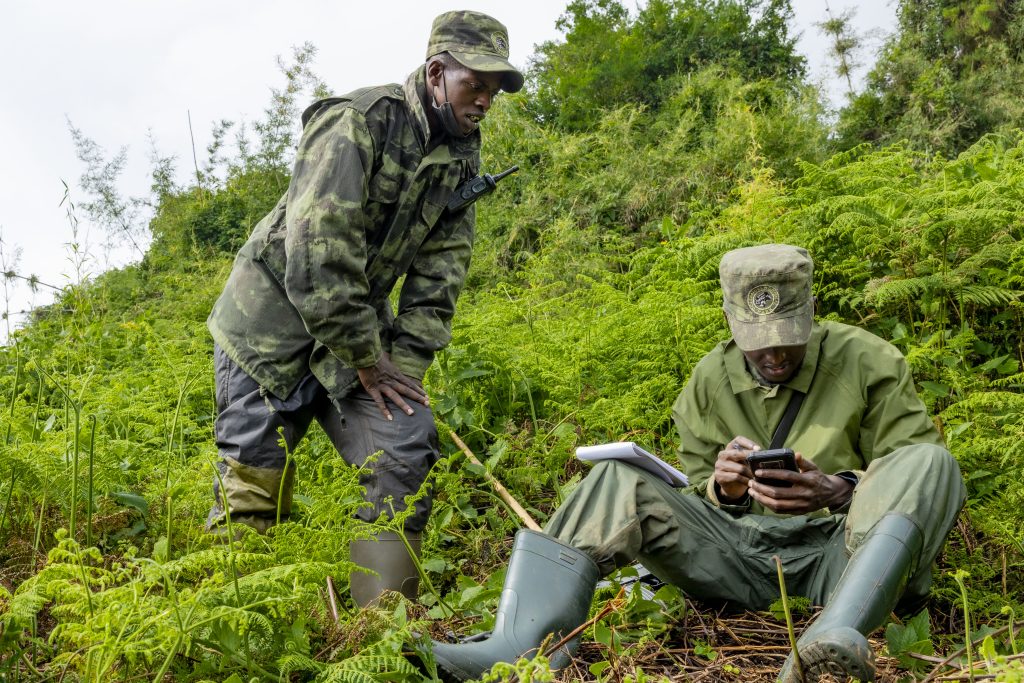Ranger Based Monitoring – Protecting Wildlife and the Habitat
Blog | 3/03/25
Since initiation, the mandate of Ranger Based Monitoring has gone way beyond species’ protection! In 1997, International Gorilla Conservation programme worked with the protected area authorities in Rwanda, Uganda and Democratic Republic of Congo to develop the Ranger Based Monitoring system, an initiative that has registered tremendous conservation outcomes including improved reporting and response to illegal activities in the protected area, ecological monitoring and profiling among others.

Previously aimed at collecting data to inform conservation decisions in the protected areas, RBM has now widened its scope to report on illegal activities, key species of fauna and flora and habituated and non-habituated gorilla groups within the protected areas.
Ranger Based Monitoring is a simple and cost-effective method of collecting data, used to monitor ecosystems and to inform park management decisions. RBM started as paper-based, rangers used to use pen and paper to report. Today, however, the parks use a digitalized Spatial Monitoring and Reporting Tool (SMART) which has made RBM recording, analysis and reporting easier.
Nelson Guma, Chief Park Warden for Bwindi Mgahinga Conservation Area credits RBM for effectively aiding monitoring and protection of mountain gorilla groups. “RBM helps the gorilla monitoring teams to keep daily track on the life of the habituated groups and provides important information on the groups’ general dynamics. RBM keeps us informed about individual gorilla health allowing us to make timely interventions whenever there is need,” says Nelson Guma.
Damascene Hakizimana, Monitoring and Research Warden at Volcanoes National Park adds that, “RBM provides park managers with information that prompts appropriate response to threats to the ecosystem. For example, information on the distribution of illegal activities determines areas to focus on or where to strengthen patrolling efforts to address the threats”.
Speaking about the initiative, rangers across the mountain gorilla range commend the innovation for aiding their work. Theoneste Bimenyimana – Ranger at Volcanoes National Park- Rwanda, shares how RBM helped him and his team to find the missing Isimbi mountain gorilla group that had gone out of daily monitoring for over a month.
RBM helps the rangers to keep track of the gorilla groups’ dynamics and to report on the health and the status of the ecosystem. It captures information on the type of food gorillas feed on, their interactions, movement and behavior patterns among others.
Commenting on the additional roles of RBM, Eustrate Uzabaho, IGCP’s Field Officer says Ranger-based monitoring and reporting provides useful information that informs management decisions about the various tourism activities allowing for safe and successful tourism to happen at the parks. “Unfortunately, this role is an often forgotten but important aspect” Eustrate adds.
IGCP continues to work closely with protected areas to improve RBM e.g. regular updates are done to the system in line with the modern monitoring systems, IGCP also facilitates periodic ranger-based monitoring meetings for parks to evaluate the performance of the innovation, assess the gaps, best practices and map out practical ways of maximizing the innovation.
Capacity building trainings for park rangers on RBM are often conducted, equipping the park staff with data collection and analysis knowledge and skills which has enabled them to continually deliver on their job and to protect the endangered mountain gorillas even better. As a result, a robust data system has been developed which has improved reporting.
According to Henry Mutabaazi, Uganda Programme Advisor for IGCP, RBM meetings aid information sharing and analysis of how the data is being used to improve conservation. On the other hand, Benjamin Mugabukomeye, Rwanda Country Coordinator for IGCP credits RBM meetings for raising pertinent conservation issues like the non-compliance to the gorilla visitation rules by visitors and under-sized patrol numbers that affect effecting park patrols among others.




